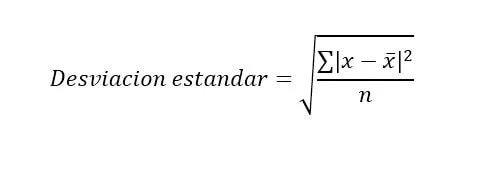Standard deviation in research/calculation/properties
The standard deviation or standard deviation (revealed with the symbol σ) is a concentration or statistical dispersion weighting for ratio variables (ratio or quotient) and interval, which is highly appreciated in descriptive statistics. Standard deviation in research
What is the standard deviation?
Mathematical definition
Mathematically , it is defined as the square root of the variance (measure of data dispersion, the square of the original data and therefore the square of its unit). Together with this value, the standard deviation is a measure (quadratic) that communicates the mean of distances that the data have in proportion to their arithmetic mean, stated in the same units as the variable.
To know precisely a set of data, it is not enough to know the measures of the main trend, but it is necessary to know the deviation of the data in relation to the arithmetic mean, in order to have a vision of these, more in line with the reality at the time of describing and interpreting them for decision making, explaining the real events with respect to those expected. Standard deviation in research
Normally it is also known as standard deviation , it refers to the mean calculation or the mean between the differences related to data and results and the larger the difference between the data, the larger the standard or standard deviation will be.
Characteristics of the standard deviation
- The amount deferred between the data and the average is measured as a positive result or equal to zero (being equal to zero when there is no variation between the data obtained).
- It is just as applicable if the data is greater or less than the average.
- It is not the average of the differences.
Uses of standard or standard deviation
- In general terms, the standard deviation is used as a tool to measure scattered data in relation to a set of original elements to determine how they differ so much from the original mean obtained and from the expected mean. Standard deviation in research
- In the area of advertising, marketing and finance.
- In the area of economics, to study price indicators and with these data make sales projections , among other activities related to planning.
- In the social sciences to measure geographical and historical data that allow to specify the demographic characteristics of an area.
- In tax and customs sciences.
- In administrative sciences.
- In cost accounting.
- In engineering projects that require control of the values obtained.
Units of measurement for standard deviation
To calculate and measure the standard deviation , the same units that refer to the data to be consulted are taken as units, because its main application is to establish the difference between an expected value and the average obtained, as an example, we have: Standard deviation in research
- When the data refer to weights, the standard deviation is described in kilograms.
- When the data refers to height, the standard deviation is described in cm.
- When the data refers to mileage, the standard deviation is described in meters or equivalent.
How is the calculation of the standard deviation performed?
To calculate it, the following formula is used:
Standard deviation =
.
- ∑ means “sum of”.
- is a value from a data set.
- number of data points.
It may seem confusing, but it breaks down and calculates one step at a time.
- It is necessary to determine the arithmetic mean of the values obtained
- The difference between the individual data and the arithmetic mean obtained is then squared.
- The arithmetic mean of the squares of the previous difference must be calculated.
- Take the square root of the mean of the squares of the differences. Standard deviation in research
Properties of the standard deviation.
- If a number is added to all the values of the variable (that is, a constant independent of the data, but which is always present in the lagged values), the standard deviation does not vary.
- In the event that the data scores are equal, their value will always be positive or equal to zero.
- If the values of a variable are multiplied by a number, the standard deviation must also be multiplied by that number, since it represents a change in magnitude in all the data.
- The total standard deviation can be calculated if there are several apportions with the same mean, also knowing their deviations. Standard deviation in research
- The standard deviation is very sensitive to the furthest data, or extreme scores. These extremes are totally necessary to be able to find the deviation, taking into account the number of values used.
- Once calculated, it is possible to determine the concentration of the data surrounding the mean. Their concentration is inversely proportional to the value of the deviation.
In summary, the standard deviation is the positive square root of the arithmetic mean of the square of the difference between the data and the mean of the values, thereby expressing a measure of distortion with respect to the original elements allowing to clarify doubts and make projections to more accurate future based on those data.
